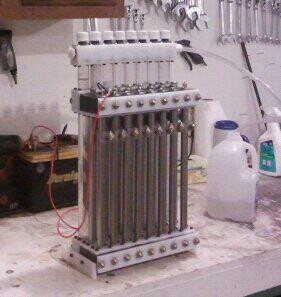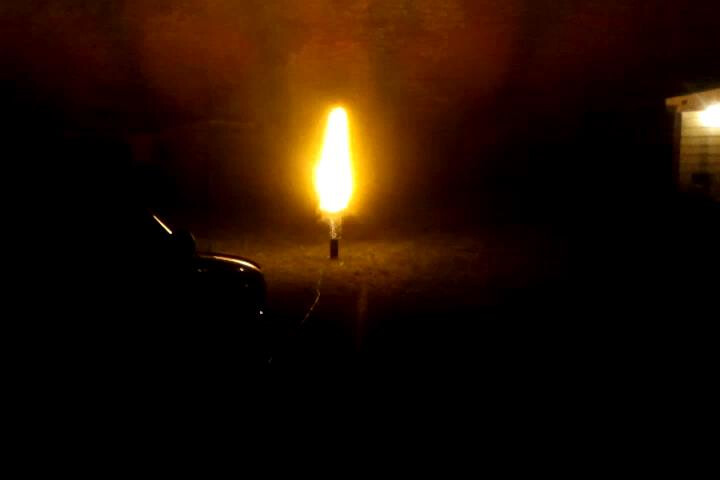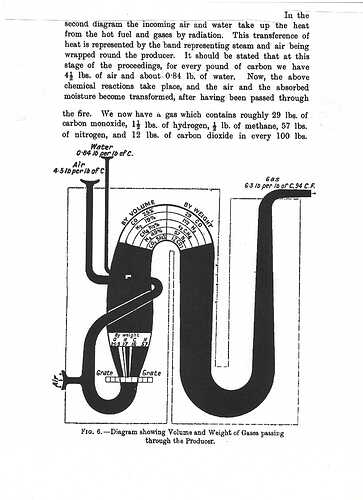Been there tried that. It did work to an extent but not enough to meet the goals I had intended. I used marbles with a high pressure pump to constantly flush this marble bed. Just made a yucky mess in there and was a pain to remove the tar glued together marbles and then clean them. So scrapped that idea and that was when I started the use the bag filters. Funny how that all works the things I would not try are the things in the end that actually work. Bag filters are the way and you can always put additional media in them.
The original filter was wood chips of progressive sizes and then oiled foam filters , It was determined that this just added more tar . Then filter of all charcoal was prescribed and I still have it . I will add shower of water to this still existing filter . The thing that was my idea did not work . I thought I could divert fluids from gases , I put a wet blanket around it poured water over it , It was just to hot to have any effect . I am not sure anyone else would have my experience because of other issues with flaws in construction and eureka features
HHO devices are how a lot of us got here into woodgas  Yeah no need to pre crack it when you can do this much more effectively via thermo carbon cracking for basically free plus we cool our reaction in the process to keep things from melting down.
Yeah no need to pre crack it when you can do this much more effectively via thermo carbon cracking for basically free plus we cool our reaction in the process to keep things from melting down.
Building an HHO device that is efficient is a big PITA!!! But I did have a great amount of fun building them and blowing stuff up with them. BOOOOOOM!!!
2 liter bottle rocket launch
Advanced cell I built that is now in Germany on a US base for an Alternative Energy Curriculum study.

Hi Thierry,
In my experience they don’t. Coz they need the suction as a pulse to move the diaphragma of the pump inside.
The other one have electric pulsing
That is an very interesting research. Maybe when a drop of water falls into the very hot heart it cracks into oxygen and hidróge… Water is known to have a strange behavior always doing unexpected things like expanding while frozing
What if you drip hot demineralized water? Hot to close 100celcius
I think historically there have been more injures , causalities from steam then wood gasification .
Historically there have been more injures , causalities from timber industry than any other occupation .
Ok charcoal gasifier builders; here is something I think I am learning with teaming the units into one. The water drip rate for each machine I am able to consistently set just as if there is only one unit. In other words the drip rate for the three units in the team is three times as much as if Im only running one machine. Like a few others I set the flow to around 1 drip pr second. I can set all three machines in the team to this same rate for each individual unit.
Any of you guys building you can also try this. Teaming the units is not complicated at all. You simply plug two or more charcoal units into a shared filter is all. This will add more stability as well, if one machine has a hic up the others will carry it until it self corrects.
Last night I had a really good run, that thing purrrred along all night for 5 1/2 without missing a beat. I mostly monitored but I did run the chop saw as that is a good intermittent load for the units. Typically if I run that saw consistent eventually it will pull the generator down running on wood gas / char gas. This run I could run that saw much longer without pulling the generator down. So I do think the added water is giving a bit more along with longer run times.
Don’t know if this question makes sense, but are you using the same sized engine with just one unit as you are with the ganged units? If so is the engine pulling enough pressure for all three to function as well as just one does?
Yes! I am running this engine on all or one. Yeah that was a concern as well. However there is plenty range on the units. When running one machine the gas is much hotter, run all three the gas is way cooler so that is telling when one unit is running its probably at the upper limit of operation. When the units are teamed they are running the lower output range but I think the processes are more efficient. I now think there is a sweet spot for charcoal reactor temps. How to define that Im still trying to figure out.
That is good to know. I always wonder if it would be possible to have a standard size and just add gasifier s for larger engines. Nice and thanks for sharing your experience.
I have run charcoal units of large and small sizes , running
generator engines from as small as 49cc up too 500 cc and they all seemed to run happily on nozzles ranging from 12mm up too 25mm dia and i have hardly ever used water drip as most were vertical nozzles .
Dave
Ok when I had Dans machine at Argo’s it originally had the evap tube nozzle concept. This was not fully tested so I did have a back up plan. Well we had to use the back up plan as the evap tube just melted away.
Well that back up plan I think is the better design anyways; it is simple and it works. So I have converted all machines that did not have the jet system installed before this and so far this system is working excellent!.
So basically I have a single nozzle like most traditional systems. Its simple, works and its not broken. However what I am doing different is instead of the air entering the end and then flowing steam or dripping water into the sides Ive reversed this. I feed the water into the very end from the outside and feed the air into an array of holes drilled into the air feed tube. The air is feeding radially right at the point where the water drip tube terminates. So you have air feeding in and grabbing the water at the center at high velocity. This sort of atomizes the water into a mist and to evenly coat the nozzle 360*. Some water mist is carried directly into the hot zone as well. This has worked very well and much more consistent than just dripping into the nozzle tube. Plus if you forget to shut off the water it will just drip out the air intake holes and also it acts as a flash back arrestor. The later was the goal of the redesign, but needed something that would work as well or better than a straight water drip.
I have been using the crank case vent for tank pressure. But I think with this new set up it may not be needed anymore as the air I think is creating a low pressure on the drip feed tube end. Need to test that further yet.
Nice, and I actually understand what you are saying for once. My fault, not yours.
So far so good, I ran a full load without using the PCV to pressurize the water tank. Ran consistent the entire time.
I did need to adjust the drip tube in a bit. You want it to terminate right at the center of the intake air holes or right to the edge that is closest to the gasifier. It worked just as I thought it would. The water drip breaks up into a mist and coats the entire nozzle walls.
Wow, I ran another full hopper load last night. The first run I didnt think to get a start time as was working to produce fuel as it was running. It powered the equipment while performing my night charge cycle for my off grid battery bank. I had thought it had ran for a bit longer than normal.
So I timed this second run and I got 2 hours. This machine is the older version with internal filter and those typically get 1 hour 15 minutes tops with the old water drip version. Both times the machine ran stable with full power the charcoal system had to offer.
My brain would love to overcomplicate this jet system. But this is working so well and is so easy. This will be the way forward for me anyways. KISS!! 
Matt, I admire your never ending enthusiasm every post you share. However this statement of yours kind of sums up my own thinking. I’ve lay awake many evenings inventing new improvments, but as long as things are working well and easy and saving me $$ every day I see no reason to change things. Maybe I could improve power or get better milage, but I decided to enjoy the ride as long as it lasts.
I bet that could be used as a carburator fuel mixer, with modifications of course.








